
This lesson allows students to analyze the Constitution and ask questions about how the Constitution talks about presidential elections.
- Subject:
- Social Science
- Material Type:
- Lesson Plan
- Provider:
- Bill of Rights Institute
- Date Added:
- 07/22/2024

This lesson allows students to analyze the Constitution and ask questions about how the Constitution talks about presidential elections.

This lesson allows students to analyze the Constitution and ask questions about how the Constitution allows for impeachment of the President.

This lesson allows students to analyze the Constitution and ask questions about how the Constitution effects the transfer of power between presidents.

This lesson allows students to analyze the Constitution and ask questions about how the Constitution relates to the institution of slavery.

This lesson allows students to analyze the Constitution and ask questions about how the Constitution lays out the President's powers.

This lesson allows students to analyze the Constitution and ask questions about how the Constitution bestows federal power to the President.

This lesson allows students to analyze the Constitution and ask questions about how the Constitution describes the President as Chief Diplomat.

This lesson allows students to analyze the Constitution and ask questions about how the Constitution allows the President to enforce the law.

This lesson allows students to analyze the Constitution and ask questions about how the Constitution lays out the President's powers.

This lesson allows students to analyze the Constitution and ask questions about how the Constitution lays out the President's powers.

Use this lesson with The Constitutional Convention Narrative and after students have done The Articles of Confederation, 1781 Primary Source activity.

This lesson contains various activites that can be used while teaching about the Constitutional Convention. Some have students compare similiarities/differences between the Convention members. Others deal with comparing the Articles of Confederacy to the Constitution, objections to the Constitution, or Madison's description of 'Federalism.'
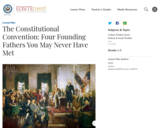
Witness the unfolding drama of the Constitutional Convention and the contributions of those whom we have come to know as the Founding Fathers. In this lesson, students will become familiar with four important, but relatively unknown, contributors to the U.S. Constitution Convention: Oliver Ellsworth, Alexander Hamilton, William Paterson, and Edmund Randolph.
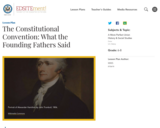
To what shared principles did the Founding Fathers appeal as they struggled to reach a compromise in the Constitutional Convention? In this lesson, students will learn how the Founding Fathers debated then resolved their differences in the Constitution. Learn through their own words how the Founding Fathers created"a model of cooperative statesmanship and the art of compromise."
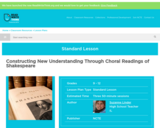
After reading "The Tempest" or any other play by William Shakespeare, students work in small groups to plan, compose, and perform a choral reading based on a character or theme.

This unit is designed for middle-school students in the Content Area of Visual Art focusing on Identity Politics, Voice, Critical Race Theory, Activism and Social Justice. The unit is accessible for modification and inclusion of all grade levels. Anti-Bias and Anti-Racist training interwoven with Social-Emotional Identification and Self-Care gives students skills and guidance to navigate humanity in the twenty-first century. The objective of the unit is for students to gain critical awareness of the self in the past, present, and future. Students will be able to project and assist in their vocality and aspirations for the self and the collective. Students will explore critical race theory and identity politics in relation to the self and their visual art practice. Through research and application, students will consolidate, frame, and expand their visual thinking to be full of self-determination and self-respect.1 Through critical analysis, students will activate their critical conscience and create a voice that is written, spoken, and established through visual representation. This visual art practice will give students a voice for change and act as a facilitator to sustain all paths of liberation.

This lesson plan focuses on the essential question: How does philosophy affect the way a judge reads the Constitution and what is the effect of that? Teachers will use the Annenberg Classroom video âA Conversation on the Constitution: Judicial Interpretationâ in which Supreme Court Justices Antonin Scalia, a strict constructionist, and Stephen Breyer, an evolutionist, debate how the Constitution should be interpreted.
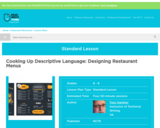
Students explore the menu genre by analyzing existing menus from local restaurants. They review adjectives and descriptive writing and then work in groups to create their own custom menus.
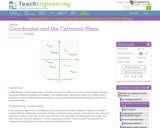
A brief refresher on the Cartesian plane includes how points are written in (x, y) format and oriented to the axes, and which directions are positive and negative. Then students learn about what it means for a relation to be a function and how to determine domain and range of a set of data points.

This lesson introduces students to the idea of biomimicry or looking to nature for engineering ideas. Biomimicry involves solving human problems by mimicking natural solutions, and it works well because the solutions exist naturally. There are numerous examples of useful applications of biomimicry, and in this lesson we look at a few fun examples.